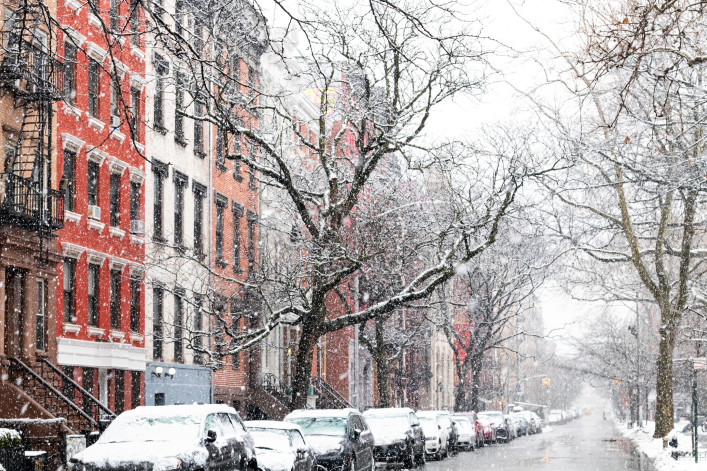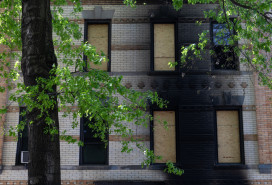Nikki's Notes: What do we need to know about buying in NYC in January for a springtime move?
- Listings may be limited in winter but less competition allows more room for negotiation
- Be sure to see any new place multiple times, preferably with a first viewing during daylight hours

Explore the neighborhood to get a sense of what it's like to live there—especially when it's frigid outside.
iStock
What do we need to know about buying in NYC in January if our goal is to move into a new place by spring?
There's definitely something appealing about being able to say "new year, new home." And that entails combining your spring cleaning with packing up and moving into your new place.
"Come January, I often hear from people who have used the downtime during the holidays to evaluate their living situation, spurring more conversation like, 'Wow, we need a different space!'" says Nikki Beauchamp, a broker at Sotheby's International Realty with over two decades of experience representing buyers and sellers in New York City.
Beauchamp says off-season buying comes with some potential drawbacks and advantages that are important to be aware of.
For starters, there might be fewer options overall given the traditional listing season happens in spring. She emphasizes, however, that inventory is only limited in terms of overall volume and not necessarily the diversity of listings. So what you're looking for may, in fact, be out there right now.
What's more, with fewer people looking in winter, there’s less risk of getting into a bidding war. Less demand can also lead to lower prices and more room for negotiation.
There are also fewer interruptions in late winter and early spring where everything grinds to a halt. "I'm thinking of the timing challenges inherent with a management company processing your condo or co-op application, which can be delayed during the peak season due to summer Fridays and holidays like the Fourth of July," she says. Another bottleneck is getting your application reviewed and approved by the board for the same reason.
Finally, a lot of the affiliated services might have more availability instead of the usual crazed rush. "So instead of going with the first moving company that answers the phone, you could talk to two or three different ones and get a real sense of who you want to hire," she says.
Starting the search
Since you haven't begun looking for a place yet, Beauchamp suggests doing a preliminary assessment.
"First, let's talk about how you live now: what you like, what you don't like, what you most want to change, and what you envision your next space being," she says. For example, one of her clients who closed on an apartment around this time knew they wanted the parents' and kids' bedrooms on opposite sides for extra privacy. Another who worked from home full-time was interested in trading an open floor plan for a layout with dedicated rooms.
"Then, we layer the combination of those answers with what's on the market and go from there," she says.
If, say, you've set your sights on getting into a new construction condo on the Upper East Side that is still under development, that is not likely to happen by April or May of this year. Likewise, having too many "must haves" on your buying list is going to further narrow the pool. Consider focusing on two or three priorities—such as location, square feet, or certain amenities—and be willing to compromise on the rest.
Navigating the winter market
Lower supply is generally associated with higher prices, though Beauchamp says that is not necessarily the case in the off-season.
"As a buyer, I would think, 'Why is this seller listing right now?' It might indicate they need to get a buyer ahead of what is generally considered the season," she says. If so, that can be to your benefit in terms of negotiating the asking price.
That's true even when buying a brand new condo—the developers might provide certain incentives during slow times. "It's always a possibility depending on the building and how sales are going, and it never hurts to ask," Beauchamp says. If your offer is in the range of where they want to be, they might be willing to get one more deal done because they need to continue hitting their contract projections, she adds.
At the other extreme are resale listings that have sat on the market for a while—a common enough scenario for properties that got lost in the pack during the bustling summer months.
Beauchamp encourages clients to at least be open to viewing these places, saying there are all sorts of reasons why something that is otherwise amazing may not sell. "If the property checks all your boxes, it checks all your boxes—so what if it's been on the market for 60 or 90 days!" And you just might get a 12 to 15 percent price reduction.
Screening listings in person
Be sure to see any new place on multiple occasions, preferably for the first time during daylight hours, which in winter means before 5 p.m. "Then you should have a second viewing in the evening to get a realistic sense of the space after dark. If you like a place in winter, odds are you're going to really love it the rest of the year."
You'll want to spend time exploring the area around the building, too, especially when you have narrowed the options to the two or three properties that are most of interest. "Walk around, have lunch or a cup of coffee. Visit the area on different days of the week and at different times to see what it will feel like to live there," she says. (And don't rely on friends' opinions; only you can make this decision.)
Having places to run errands, shop, and dine nearby is particularly helpful in winter. Beauchamp tells people that when she's not running around showing properties, she generally doesn't want to leave her UES neighborhood. "On a really cold day, I have a maximum radius of about 20 blocks, and that's pushing it."
Selling and buying simultaneously
Of course, if you plan to sell your current place while you are buying another, that is a different scenario that needs to be part of the initial discussion.
"Then it's about how quickly we can list your property and find a buyer; it's also about looking at your broader financials to know which needs to come first," Beauchamp says. Sometimes, the timing may not work out for that April/May/June move.
Even if it does, Beauchamp says the sell-to-buy situation impacts the pricing strategy for both places, and it's a moving target. You should plan for the worst-case scenario, which would be that you have to wait until you sell your home before closing on the next.
"I'm here to have that conversation with you because I'm a numbers geek and can come up with a winning strategy based on a deep understanding of the buy and sell sides of the market," she says.
You may also want to revise your original springtime target based on what you are seeing. Are you willing to settle on a place just to meet that deadline? If not, Beauchamp suggests keeping an open end date.
"My clients who just closed on their dream apartment had recently resurfaced after deciding that they were not really in a rush and weren't finding anything," she offers as a takeaway. "Something will eventually turn up!"
Nikki Beauchamp is a multilingual real estate advisor at Sotheby’s International Realty with over two decades of experience representing buyers and sellers in New York City and globally. Known for her data-driven approach and market expertise, she provides clients with valuable insights to make informed decisions. Beauchamp is an active member of the Real Estate Board of New York, currently serving as co-chair of the New York Residential Specialist executive committee. To submit a question for this column click here. To reach Nikki call (212) 606-4152 or contact via her website.


























